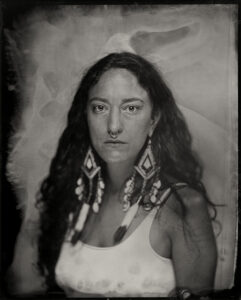Why do we take portraits of people? For hundreds of years, much of the function was to preserve someone’s image, flaunt wealth, or, among upper classes, advertise yourself for marriage to long-distance suitors. Other times, it’s to record history or shine light on a certain type of person or way of life. Today, selfies, video calls, and Instagram posts serve a lot of the same function, but still we make portraits. Why?
Kali Spitzer’s portrait series Bodies of, Bodies Within, currently being shown at the Art Gallery of Greater Victoria (AGGV), shines a light on some modern reasons we might still take portraits. Focusing on BIPOC, queer, and trans bodies, Spitzer uses one of the oldest forms of photography we have to show the beauty and spirit of those who are often overlooked for more formal portraits.

The method is called tintype, and it’s almost as old as the concept of photography itself. Dating back to before the American Civil War, it was primarily used for the exact types of portraits Spitzer is capturing. With so many digital and film options available today, Spitzer’s choice to use a more traditional process is meaningful to the message. Since we typically associate older photographs with historical importance, Spitzer’s methodology is incorporating marginalized people into that history. In doing so, she’s also noting the importance of recording these communities as part of our collective history.
This is especially important considering that our history books have been all too eager to ignore and disregard Spitzer’s own community.
Coming from the Kaska Dena nation of northern BC on her father’s side and a Jewish Transylvanian tradition on her mother’s side, Spitzer is intimately familiar with the ways in which a people’s history can be swept away. Their struggles, triumphs, joys, values, and unique beauty can all be destroyed in favour of a narrative that better suits people in power. Because of this, many people seem to think that queerness or the empowerment of racialized people is a recent trend—this isn’t the case.
By using historic forms of photography, Spitzer is reincorporating queer, trans, and BIPOC people into a narrative that they’ve always been present in but were excluded from the record of.
Spitzer isn’t only changing who we take photos of—she also hopes to challenge the conventions of portraiture itself. Much of our modern practice comes from visual techniques which were developed by a very small group of people who were almost exclusively able-bodied white men. The camera, a stand-in for the artist’s own visual perspective, forces the audience into seeing the way the photographer sees the world. When the camera is then passed to someone who sees the world differently, you’re offered a new perspective when seeing through their eyes.
In Bodies of, Bodies Within, Spitzer shows us how she views her community. Beautiful, but on its own terms. Beauty, in this case, is not defined by the rigid guidelines of advertising, but rather in authenticity, diversity, and the owning of one’s culture. Ever present throughout time, across cultures, and worth documenting.
As a queer person, this work meant a lot to me. Seeing these bodies on their own terms felt powerful, and Spitzer’s photographic perspective is one full of love and respect. AGGV is on the right track, as it continues to uplift artists who explore and share perspectives which have, historically, been excluded from these spaces.
Bodies of, Bodies Within
Until Sunday, March 17
Art Gallery of Greater Victoria
aggv.ca
